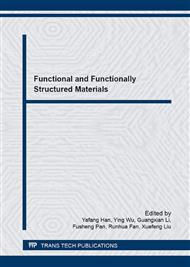[1]
A. F. Ismail and L. I. B. David. A review on the latest development of carbon membranes for gas separation, J. Membr. Sci., (2001)193: 1-18.
Google Scholar
[2]
Xue Ning, William J. Koros, Carbon molecular sieve membranes derived from Matrimid polyimide for nitrogen/methane Separation, Carbon 66 (2014) 511-522.
DOI: 10.1016/j.carbon.2013.09.028
Google Scholar
[3]
Xuezhong He, Jon Arvid Lie, Edel Sheridan, and May-Britt Hagg, Preparation and Characterization of Hollow Fiber Carbon Membranes from Cellulose Acetate Precursors, Ind. Eng. Chem. Res., 50 (2011) 2080–(2087).
DOI: 10.1021/ie101978q
Google Scholar
[4]
Yuichiro Hirota, Akinori Ishikado, Yoshiaki Uchida, Yasuyuki Egashira, Norikazu Nishiyama, Pore size control of microporous carbon membranes by post-synthesis activation and their use in a membrane reactor for dehydrogenation of methylcyclohexane, Journal of Membrane Science, 440 (2013).
DOI: 10.1016/j.memsci.2013.04.010
Google Scholar
[5]
Sandra C. Rodrigues, Roger Whitley, Adélio Mendes, Preparation and characterization of carbon molecular sieve membranes based on resorcinol–formaldehyde resin, Journal of Membrane Science, 459 (2014) 207–216.
DOI: 10.1016/j.memsci.2014.02.013
Google Scholar
[6]
Evangelos P. Favvas, Nikolaos S. Heliopoulos, Sergios K. Papageorgiou, Athanasios Ch. Mitropoulos, George C. Kapantaidakis, Nick K. Kanellopoulos, Helium and hydrogen selective carbon hollow fiber membranes: The effect of pyrolysis isothermal time, Separation and Purification Technology, 142 (2015).
DOI: 10.1016/j.seppur.2014.12.048
Google Scholar
[7]
Ywu-Jang Fu , Kuo-Sung Liao, Chien-Chieh Hu, Kueir-Rarn Lee, Juin-Yih Lai, Development and characterization of micropores in carbon molecular sieve membrane for gas separation, Microporous and Mesoporous Materials, 143 (2011) 78–86.
DOI: 10.1016/j.micromeso.2011.02.007
Google Scholar
[8]
Rachana Singh, William J. Koros, Carbon molecular sieve membrane performance tuning by dual temperature secondary oxygen doping (DTSOD), Journal of Membrane Science , 427 (2013) 472–478.
DOI: 10.1016/j.memsci.2012.10.004
Google Scholar
[9]
W.N.W. Salleh, A.F. Ismail, Effects of carbonization heating rate on CO2 separation of derived carbon membranes, Separation and Purification Technology, 88 (2012) 174–183.
DOI: 10.1016/j.seppur.2011.12.019
Google Scholar
[10]
Wei Wei, Haoquan Hu, Guotong Qin, Longbo You, Guohua Chen. Pore structure control of phenol–formaldehyde based carbon microfiltration membranes. Carbon, 42 (2004) 679-681.
DOI: 10.1016/j.carbon.2003.12.083
Google Scholar
[11]
C R Choe, K H Lee. Effect of processing parameters on the mechanical properties of carbonized phenolic resin, Carbon, 30 (1992) 247-249.
DOI: 10.1016/0008-6223(92)90086-c
Google Scholar
[12]
Wei Wei, Guotong Qin, Haoquan Hu, Longbo You, Guohua Chen, Preparation of supported carbon molecular sieve membrane from novolac phenol–formaldehyde resin, Journal of Membrane Science, 303 (2007) 80–85.
DOI: 10.1016/j.memsci.2007.06.055
Google Scholar


